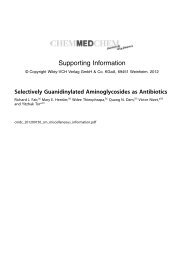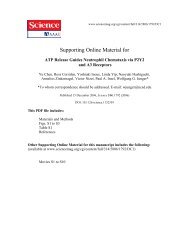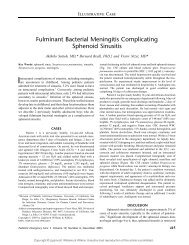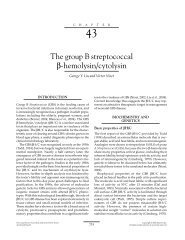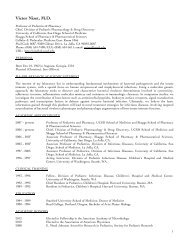BACTERIAL SEPSIS AND MENINGITIS - Nizet Laboratory at UCSD
BACTERIAL SEPSIS AND MENINGITIS - Nizet Laboratory at UCSD
BACTERIAL SEPSIS AND MENINGITIS - Nizet Laboratory at UCSD
Create successful ePaper yourself
Turn your PDF publications into a flip-book with our unique Google optimized e-Paper software.
TABLE 6–15 Differential Diagnosis: Clinical Signs Associ<strong>at</strong>ed with Neon<strong>at</strong>al Sepsis and Some Noninfectious Conditions—cont’d<br />
Hypoglycemia<br />
Inborn errors of metabolism, including galactosemia, urea cycle disorders, organic acidemias<br />
Ileus secondary to pneumonia<br />
Congenital adrenal hyperplasia<br />
Gastric perfor<strong>at</strong>ion<br />
Neon<strong>at</strong>al drug withdrawal syndrome<br />
Lethargy<br />
CNS disease, including hemorrhage, hypoxia, or subdural effusion<br />
Congenital heart disease<br />
Neon<strong>at</strong>al drug withdrawal syndrome<br />
Hypoglycemia<br />
Hypercalcemia<br />
Familial dysautonomia<br />
Seizure Activity (Tremors, Hyperactivity, Muscular Twitching)<br />
Hypoxia<br />
Intracranial hemorrhage or kernicterus<br />
Congenital CNS malform<strong>at</strong>ions<br />
Neon<strong>at</strong>al drug withdrawal syndrome<br />
Hypoglycemia<br />
Hypocalcemia<br />
Hypon<strong>at</strong>remia, hypern<strong>at</strong>remia<br />
Hypomagnesemia<br />
Inborn errors of metabolism, including urea cycle disorders, organic acidemias, galactosemia, glycogen storage disease, peroxisomal disorders<br />
Pyridoxine deficiency<br />
Petechiae, Purpura, and Vesiculopustular Lesions<br />
Birth trauma<br />
Blood group incomp<strong>at</strong>ibility<br />
Neon<strong>at</strong>al isoimmune thrombocytopenia<br />
M<strong>at</strong>ernal idiop<strong>at</strong>hic thrombocytopenic purpura<br />
M<strong>at</strong>ernal lupus erythem<strong>at</strong>osus<br />
Drugs administered to mother<br />
Giant hemangioma (Kasabach-Merritt syndrome)<br />
Thrombocytopenia with absent radii syndrome<br />
Dissemin<strong>at</strong>ed intravascular coagulop<strong>at</strong>hy<br />
Coagul<strong>at</strong>ion factor deficiencies<br />
Congenital leukemia<br />
Child abuse<br />
Cutaneous histiocytosis<br />
CNS, central nervous system; G6PD, glucose-6-phosph<strong>at</strong>e dehydrogenase.<br />
FEVER <strong>AND</strong> HYPOTHERMIA<br />
The temper<strong>at</strong>ure of an infant with sepsis may be elev<strong>at</strong>ed,<br />
depressed, or normal [447–453]. In a multicenter survey<br />
of nearly 250 infants with early-onset group B streptococcal<br />
bacteremia, approxim<strong>at</strong>ely 85% had a normal temper<strong>at</strong>ure<br />
(36 C to 37.2 C [96.8 F to 99 F]) <strong>at</strong> the time of<br />
their admission to the NICU [447]. Comparing temper<strong>at</strong>ures<br />
by gest<strong>at</strong>ional age, it was observed th<strong>at</strong> term infants<br />
were more likely to have fever than preterm infants (12%<br />
versus 1%), whereas preterm infants more frequently had<br />
CHAPTER 6 Bacterial Sepsis and Meningitis<br />
249<br />
hypothermia (13% versus 3%). Phagocytes of an infant<br />
born after an uncomplic<strong>at</strong>ed labor can produce adult concentr<strong>at</strong>ions<br />
of interleukin-1, a potent pyrogen. The phagocytes<br />
of infants born after cesarean section have a markedly<br />
suppressed ability to produce this pyrogen [454]. In the<br />
studies reviewed in Table 6–13, approxim<strong>at</strong>ely half of the<br />
infants had fever. Hypothermia, which was mentioned in<br />
one study, occurred in 15% of the infants.<br />
Fever is variably defined for newborns. A temper<strong>at</strong>ure<br />
of 38 C (100.4 F) measured rectally generally is accepted



